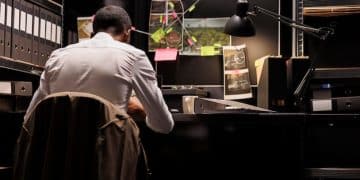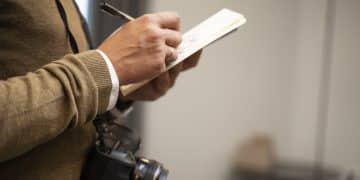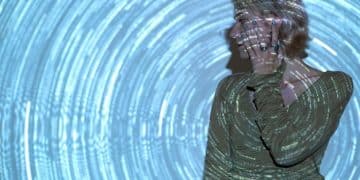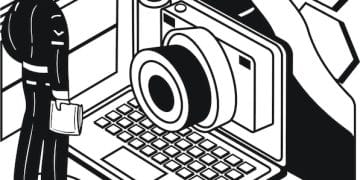Copyright & Fair Use: Protecting Your Content Online
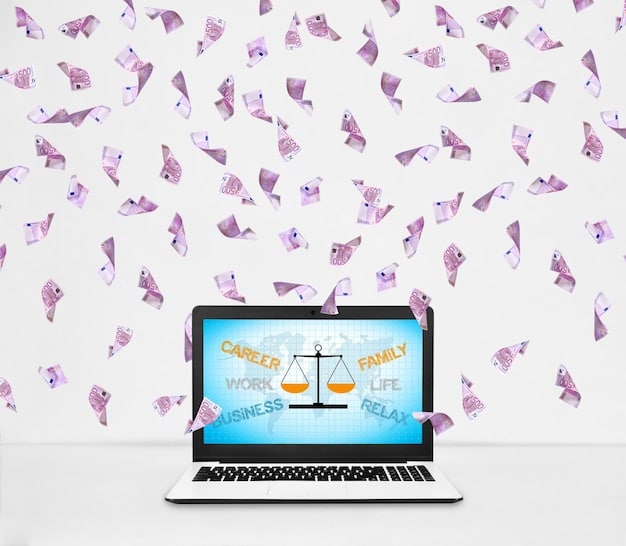
Anúncios
Copyright and fair use are critical concepts for navigating the digital age, determining how creators can protect their work while allowing others to use it legally and ethically.
Anúncios
Navigating the digital age requires a solid understanding of copyright and fair use to protect your content and respect the rights of others. This article explores these crucial concepts, providing practical guidance for creators and users alike.
Copyright Law in the Digital Age
Copyright law is the cornerstone of content protection in the digital age, granting creators exclusive rights over their original works. These rights encompass various aspects, including reproduction, distribution, and adaptation, ensuring creators have control over how their content is used and shared.
Anúncios
To effectively navigate the complexities of copyright law, it’s essential to understand its core principles and how they apply in the online environment. This understanding empowers creators to protect their intellectual property while also guiding users on how to respect copyright laws while using online content.
What is Copyright?
Copyright is a legal right granted to the creators of original works of authorship, including literary, dramatic, musical, and artistic works. This right protects the expression of an idea, not the idea itself. Here’s a breakdown of what copyright entails:
- Originality: The work must be original and not copied from another source.
- Tangible Form: The work must be fixed in a tangible medium, such as writing, recording, or digital format.
- Automatic Protection: Copyright protection is generally automatic upon creation, without the need for registration.
Rights Granted by Copyright
Copyright owners have several exclusive rights, allowing them to control how their work is used. These rights include:
- Reproduction: The right to make copies of the work.
- Distribution: The right to distribute copies of the work to the public.
- Adaptation: The right to create derivative works based on the original.

In conclusion, copyright law serves as a critical framework for protecting the rights of creators in the digital age, ensuring they have control over their original works and can benefit from their creative endeavors.
Understanding Fair Use
Fair use is a legal doctrine that permits the use of copyrighted material without obtaining permission from the copyright holder under certain circumstances. It provides a crucial balance between protecting the rights of copyright owners and promoting freedom of expression, research, and education.
Understanding fair use is essential for educators, researchers, journalists, and anyone who uses copyrighted material in their work. Knowing the boundaries of fair use can help avoid copyright infringement and promote responsible content creation and usage.
The Four Factors of Fair Use
U.S. copyright law outlines four factors that courts consider when determining whether a particular use of copyrighted material qualifies as fair use:
- Purpose and Character of the Use: Is the use transformative, adding new expression or meaning? Is it for commercial or non-profit educational purposes?
- Nature of the Copyrighted Work: Is the work factual or creative? Is it published or unpublished?
- Amount and Substantiality of the Portion Used: How much of the work was used in relation to the whole? Was the portion used the “heart” of the work?
- Effect of the Use on the Potential Market: Does the use harm the market for the original work? Could the use be a substitute for the original?
Examples of Fair Use
To better understand fair use, consider these common scenarios:
- Commentary and Criticism: Using excerpts of a book in a review.
- News Reporting: Quoting passages from a speech in a news article.
- Teaching: Distributing copies of articles for classroom use.
In summary, fair use is a vital exception to copyright law, allowing for the legal use of copyrighted material without permission, provided that the use meets certain criteria and balances the rights of copyright owners with the public interest.
Copyright vs. Fair Use: Key Differences
Copyright and fair use are often discussed together, but they represent distinct concepts in intellectual property law. Copyright protects the rights of creators, while fair use provides exceptions for certain uses of copyrighted material. Understanding their differences is crucial for navigating the legal landscape of content creation and use.
Knowing when copyright protection applies and when fair use allows for the use of copyrighted material can help creators and users avoid legal pitfalls and foster a culture of respect for intellectual property rights.
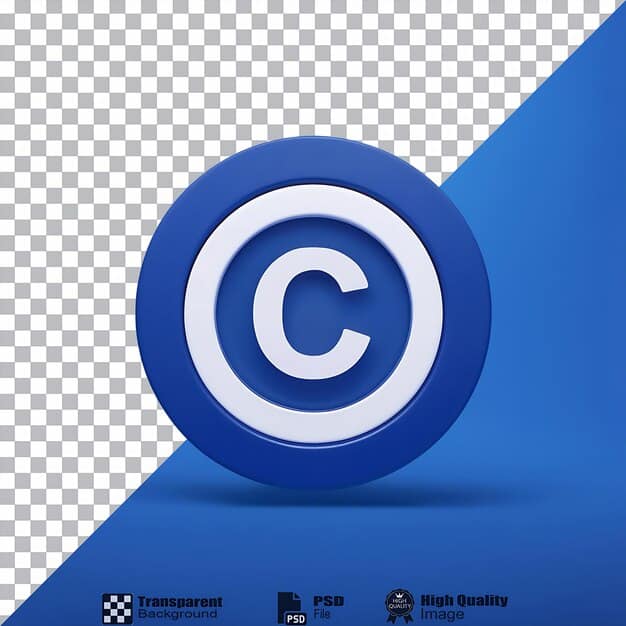
Copyright: Protecting Creators’ Rights
Copyright is a legal right that protects the original works of authorship. It gives creators exclusive control over how their work is used, providing them with a means to profit from their creative endeavors.
The main characteristics of copyright include:
- Copyright protection is automatic upon creation.
- Copyright lasts for the life of the author plus 70 years.
- Copyright owners have exclusive rights to reproduce, distribute, and display their work.
Fair Use: Balancing Public Interest
Fair use is a legal doctrine that allows the use of copyrighted material without permission for purposes such as criticism, commentary, news reporting, teaching, scholarship, and research.
Key aspects of fair use include:
- Fair use is determined on a case-by-case basis.
- It balances the rights of copyright owners with the public interest.
- The four factors of fair use guide the analysis.
In conclusion, while copyright protects the rights of creators, fair use ensures that society can benefit from the use of copyrighted material in certain circumstances, fostering innovation and free expression.
Best Practices for Protecting Your Content
Protecting your content in the digital age is essential for maintaining control over your creative work and preventing unauthorized use. Implementing best practices for copyright protection can help safeguard your intellectual property rights and deter infringement.
These protective measures not only help enforce your rights but also educate others about the value of your creative work and the importance of respecting copyright laws.
Copyright Registration
While copyright protection is automatic upon creation, registering your work with the U.S. Copyright Office provides additional legal benefits. Registration creates a public record of your copyright claim and allows you to sue for infringement in federal court.
Watermarking Your Content
Adding watermarks to your images and videos is a simple yet effective way to deter unauthorized use. A watermark is a visible or invisible overlay that identifies you as the copyright owner.
Monitoring for Infringement
Regularly monitor the internet for unauthorized copies of your work. Use tools like Google Alerts or specialized copyright monitoring services to track where your content is being used.
In summary, taking proactive steps to protect your content, such as copyright registration, watermarking, and infringement monitoring, can help maintain control over your creative work and enforce your copyright rights effectively.
Common Copyright Infringement Scenarios
Copyright infringement, also known as piracy, occurs when someone uses copyrighted material without permission from the copyright owner. Understanding common infringement scenarios is crucial for avoiding legal trouble and respecting the rights of creators.
Recognizing these scenarios can help prevent unintentional infringement and promote a culture of respect for intellectual property rights in the digital environment.
Downloading Illegal Content
Downloading music, movies, or software from unauthorized sources is a common form of copyright infringement. These downloads often involve pirated content distributed without permission.
Sharing Copyrighted Material
Sharing copyrighted material online, such as posting a movie on a file-sharing site or distributing copies of a book, is also a violation of copyright law.
Using Images Without Permission
Using images found online without obtaining permission from the copyright owner is a frequent infringement scenario. Many images are protected by copyright and cannot be used without a license.
In conclusion, understanding common copyright infringement scenarios, such as downloading illegal content, sharing copyrighted material, and using images without permission, is crucial for avoiding legal trouble and promoting respect for intellectual property rights.
The Future of Copyright in the Digital Age
The digital age presents both challenges and opportunities for copyright law. As technology evolves, copyright law must adapt to address new forms of content creation, distribution, and consumption. Exploring the future of copyright involves considering how these changes will shape the legal landscape and the protection of creative works.
Analyzing these trends can help creators and policymakers develop strategies to protect intellectual property rights while fostering innovation and creativity in the digital environment.
Artificial Intelligence and Copyright
The rise of artificial intelligence (AI) raises complex questions about copyright. Who owns the copyright to works created by AI? How does copyright apply to the training data used to develop AI models?
Blockchain and Copyright
Blockchain technology offers new ways to manage and enforce copyright. It can be used to create a decentralized system for tracking and licensing copyrighted material.
Global Copyright Harmonization
Efforts to harmonize copyright laws across different countries are ongoing. Greater harmonization could simplify international copyright enforcement and reduce cross-border infringement.
In summary, the future of copyright in the digital age will be shaped by emerging technologies such as AI and blockchain, as well as ongoing efforts to harmonize copyright laws globally, requiring continuous adaptation and innovation to effectively protect creative works.
| Key Concept | Brief Description |
|---|---|
| ©️ Copyright | Legal right protecting creators’ original works. |
| ⚖️ Fair Use | Allows use of copyrighted material without permission. |
| 👮 Infringement | Using copyrighted work without permission. |
| 🛡️ Content Protection | Measures to safeguard intellectual property rights. |
Frequently Asked Questions (FAQ)
▼
In the United States, copyright protection generally lasts for the life of the author plus 70 years. For corporate works, the term is either 95 years from publication or 120 years from creation, whichever expires first.
▼
You can register your copyright online through the U.S. Copyright Office website. The process involves filling out an application form and submitting a copy of your work. There is a fee associated with copyright registration.
▼
Fair use is limited by the four factors, which include the purpose and character of the use, the nature of the copyrighted work, the amount used, and the effect on the market. Commercial uses are less likely to be considered fair use.
▼
If your copyright is infringed, you can send a cease and desist letter to the infringer. If the infringement continues, you may need to file a lawsuit in federal court. Registering your copyright beforehand strengthens your legal position.
▼
No, it’s not always necessary. Fair use allows some uses without permission. Also, works in the public domain can be used freely. Always check the copyright status and consider fair use factors before using copyrighted material.
Conclusion
Understanding the intricacies of copyright and fair use is paramount in today’s digital landscape. By adhering to best practices, respecting intellectual property rights, and staying informed about evolving legal standards, creators and users can navigate the digital world confidently and ethically.
